Today is International Women's Day! On this occasion, we're taking a look back at women's history in tech and highlighting notable women who have driven innovation and led change in the technology sector.
Remembering 5 Notable Women Who Have Driven Innovation in the Tech Industry
In the mid-twentieth century, the tech industry was dominated by women. Programming, computer design, computer maintenance, innovation, and even computerized “war machines," used to decrypt enemy communications, were traditionally feminized careers.
The origin story of the early electronic computing industry is filled with contributions from women. It is undeniable that women have left a lasting mark on the industry and continue to make essential contributions. To celebrate this rich history, we're highlighting five notable women in tech.
Grace Hopper
December 9, 1906 to January 1, 1992
Computer Scientist and United States Navy Rear Admiral
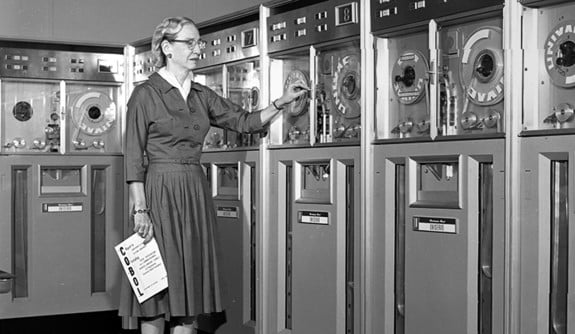
"We're flooding people with information. We need to feed it through a processor. A human must turn information into intelligence or knowledge. We've tended to forget that no computer will ever ask a new question." (Photo: Computer History Museum).
Grace Hopper was a computer scientist and naval officer. She received a master’s degree (1930) and a Ph.D. (1934) in mathematics from Yale. She is considered one of the first three modern “programmers” and is best known for her trailblazing contributions to developing computer languages.
She was one of the first programmers of the Harvard Mark I, a general-purpose electromechanical computer used in the war effort during the last part of World War II. She pioneered computer programming and invented one of the first compiler-related tools. This translator-like program transforms computer code written in one programming language into another.
Moreover, she popularized the idea of machine-independent programming languages, which led to the development of the Common Business-Oriented Language (COBOL), an early high-level programming language designed for business use. COBOL is still used in companies and governments' business, finance, and administrative systems.
After the war, she continued to serve in the military, rising to the rank of Rear Admiral and contributing to the advancement of computer technology. She has received numerous accolades for her contribution to the computer sciences. Grace left an inimitable legacy as a brilliant programmer and a pioneering woman in male-dominated fields.
Jean Bartik
December 27, 1924 to March 23, 2011
Computer Programmer and Software Pioneer
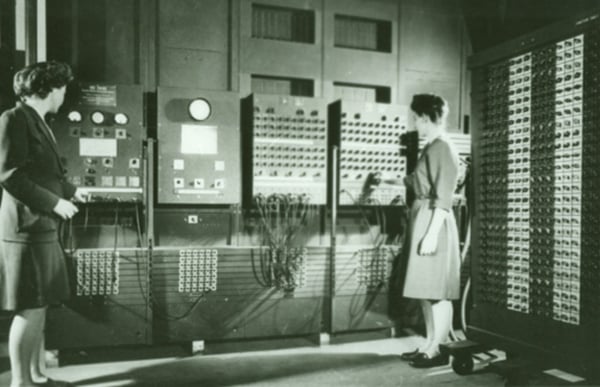
Jean Bartik left, working on the ENIAC, in 1945. (Photo: United States Army Archives).
Jean Bartik was a computer programmer and software pioneer. She attended Northwest Missouri State Teachers College, now Northwest Missouri State University, where she majored in mathematics. She was one of the original women members who programmed the ENIAC, or Electronic Numerical Integrator and Computer. This computer is credited as the first all-electronic digital computer that solved a large class of numerical problems through reprogramming.
The ENIAC was designed to calculate the firing trajectories for artillery shells. It was completed in 1946, too late to be used during World War II, but it was a milestone in the evolution of modern computing. She began her career at the University of Pennsylvania, manually calculating ballistics trajectories and then using the ENIAC to complete these calculations. She and her colleagues developed and codified many programming fundamentals while working on the ENIAC.
Jean went on to work as a writer, manager, engineer, and programmer at various technical companies. In 2009, she received a Pioneer Award from the IEEE Computer Society, and in 2008, the Computer History Museum in Mountain View, Calif., named her a fellow.
Dame Stephanie Shirley
September 16, 1933 to Present
Information Technology Pioneer, Businesswoman, and Philanthropist
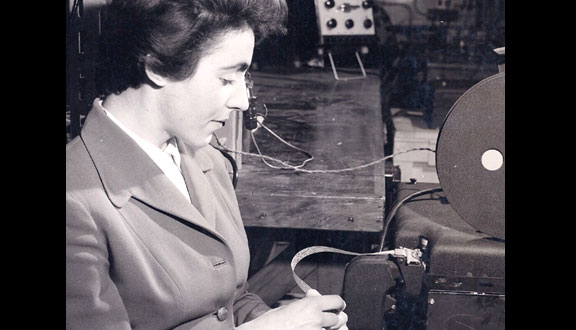
"A lot of people go into business to make money. I really didn't; I went in with a mission for women. Conversely, I was determined never, ever to be poor again." (Photo: British Library).
Stephanie "Steve" Shirley is a technology pioneer who founded an innovative software company in 1962, employing home-based women as part-time workers. She has a degree in mathematics from Sir John Cass College.
In the 1950s, she worked at the Post Office Research Station in the UK, where she built computers from scratch and wrote machine language code. She took evening classes for six years to obtain an honors degree in mathematics. While at the Post Office, she helped develop electronic telephone exchanges and the premium bond computer, "Ernie."
In 1962, she founded the software company Freelance Programmers (later FI, then Xansa, which was acquired by Steria and is now part of the Sopra Steria Group). Her innovative work practices primarily focused on creating job opportunities for women with dependents, and she predominantly employed women in these roles.
She received her BSc in 1956 and was appointed Officer of the Order of the British Empire (OBE) in the 1980 Birthday Honors for industry services; Dame Commander of the Order of the British Empire (DBE) in the 2000 New Year Honors for services to information technology; and Member of the Order of the Companions of Honor (CH) in the 2017 Birthday Honors for services to the IT industry and philanthropy.
In 1987, she gained the Freedom of the City of London. She was President of the British Computer Society from 1989 to 1990 and Master of the IT livery company 1992-93. In 1985, she was awarded the Recognition of Information Technology Award. In 1999, she received the Mountbatten Medal.
Stephanie retired in 1993 but has continued championing progress in the fields she loves. She supports research into autism spectrum disorders and organizations that promote the improvement of the IT industry and the Internet's role in society.
Margaret Hamilton
August 17, 1936 to Present
Computer Scientist and Systems Engineer
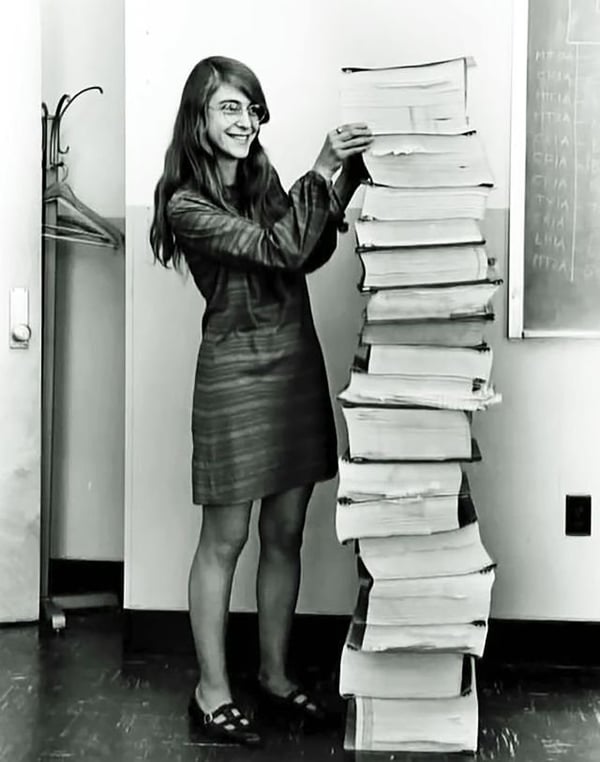
Margaret stands beside stacks of code for software that she and her team developed for the guidance system on the NASA Apollo program in 1969. (Photo: MIT).
Margaret Hamilton is a computer scientist and systems engineer credited with coining "software engineering." She studied mathematics at the University of Michigan and earned a Bachelor of Arts (BA) in mathematics with a minor in philosophy from Earlham College in 1958.
In the 1960s, she worked at MIT's meteorology department, developing software that predicted weather on the LGP-30 and PDP-1 computers. She went on to become the Director of the Software Engineering Division at the MIT Instrumentation Laboratory and led a team of developers in designing the onboard flight software for the Apollo space program. She created and developed new methods for building flight software, applying these methods to the development of Apollo and Skylab software, as well as defining the requirements for the Shuttle system software.
In 2016, US President Obama awarded her the Presidential Medal of Freedom for her work leading the development of onboard flight software for NASA's Apollo Moon missions.
Lynn Conway
January 2, 1938 to Present
Computer Scientist, Electrical Engineer, Inventor, and Transgender Activist
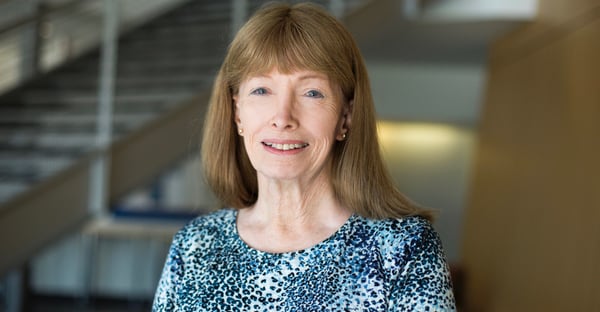
Lynn Conway championed the VLSI Revolution in Microchip Design (Photo: Women You Should Know).
Lynn Conway is a computer scientist, electrical engineer, and inventor notable for several pioneering achievements in the field of computer science. She holds B.S. and M.S.E.E. degrees from Columbia University's School of Engineering and Applied Science.
She led the way in microelectronics chip design, and her innovations during the 1970s at the Xerox Palo Alto Research Center (PARC) have had a profound impact on chip design worldwide. Her work in VLSI — very large-scale integrated circuits — helped to revolutionize computing. With Caltech engineering professor Carver Mead, Conway re-conceptualized chip processing. She and Mead collaborated on a textbook that has become standard at universities worldwide. Many tech companies and computing methods rely on the foundations of her work.
She worked at IBM in the 1960s and is credited with inventing generalized dynamic instruction handling, an essential advancement that many modern computer processors still utilize to enhance performance.
In the late 1960s, she underwent gender transition, and today, she is an advocate and activist for transgender issues, supporting awareness and speaking out against the psychiatric pathologization of gender variance.
In 1989, Conway was elected to the National Academy of Engineering and, in 2009, was recognized by IEEE as a computer pioneer. She is currently a professor emerita of electrical engineering and computer science at the University of Michigan, Ann Arbor, where she has taught since the 1980s.
Inspiring Women to Shape the Future of Tech
At Intellis, the future of tech should include people of every color, gender, belief, origin, and community. It should be accessible, flexible, and inclusive. This vision aligns with our mission to "strive for team excellence and maintain an environment that allows for continuous improvement of individuals and our organization."
Talk to Us Directly
Learn more about Intellis and our software solutions.
--
Additional Resources


